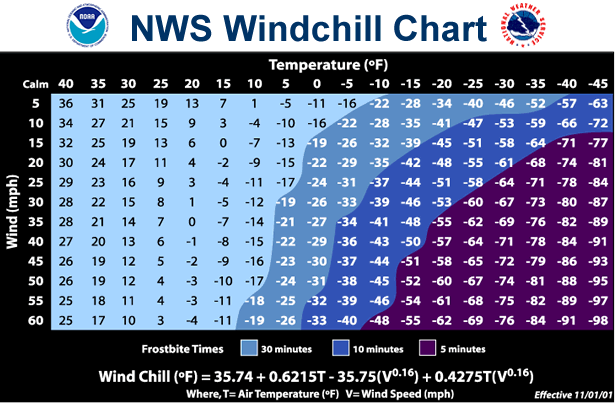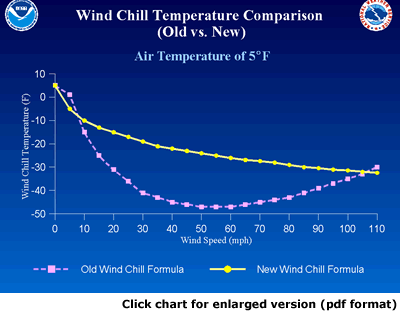|
|

|
|
In 2001, NWS implemented an updated Windchill Temperature
(WCT) index. The change improves upon the former WCT Index used
by the NWS and the Meteorological Services of Canada, which was
based on the 1945 Siple and Passel Index.
In the fall of 2000, the Office of the Federal Coordinator for Meteorological
Services and Supporting Research (OFCM) formed a group consisting
of several Federal agencies, MSC, the academic community (Indiana
University-Purdue University in Indianapolis (IUPUI), University
of Delaware and University of Missouri), and the International Society
of Biometeorology to evaluate and improve the wind chill formula.
The group, chaired by the NWS, is called the Joint Action Group for
temperature Indices (JAG/TI). JAG/TI's goal is to upgrade and standardize
the index for temperature extremes internationally (e.g. Windchill
Index).
The current formula uses advances in science, technology, and computer
modeling to provide a more accurate, understandable, and useful formula
for calculating the dangers from winter winds and freezing temperatures. |
|
 Clinical trials were conducted at the Defence
and Civil Institute of Environmental Medicine in Toronto, Canada,
and the trial results were used to improve the accuracy of the new
formula and determine frostbite threshold values. Clinical trials were conducted at the Defence
and Civil Institute of Environmental Medicine in Toronto, Canada,
and the trial results were used to improve the accuracy of the new
formula and determine frostbite threshold values.
Standardization of the WCT Index among the meteorological community
provides an accurate and consistent measure to ensure public safety.
The new wind chill formula is now being used in Canada and the United
States.
Specifically, the new WCT index:
- Calculates wind speed at an average height of five feet (typical
height of an adult human face) based on readings from the national
standard height of 33 feet (typical height of an anemometer)
- Is based on a human face model
- Incorporates modern heat transfer theory (heat loss from the body
to its surroundings, during cold and breezy/windy days)
- Lowers the calm wind threshold to 3 mph
- Uses a consistent standard for skin tissue resistance
- Assumes no impact from the sun (i.e., clear night sky).
Public Notification
of New Windchill Temperature Index
|
Note: Windchill Temperature is only defined for temperatures
at or below 50 degrees F and wind speeds above 3 mph. Bright sunshine may
increase the wind chill temperature by 10 to 18 degrees F. |
|
| Last Updated:
February 25, 2008
|
|


